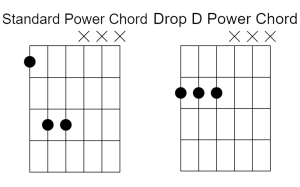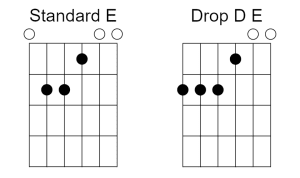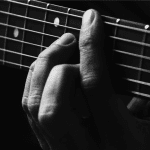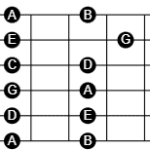Drop D tuning is a common alternative tuning for the guitar. Standard tuning, from low to high, is E-A-D-G-B-E. The guitar is tuned that way for a few reasons, but it’s not the only way to tune it. While standard tuning has its advantages for being able to easily play chords and play melodies, sometimes and alternative type of tuning can be more convenient for certain styles of music and certain playing techniques.
Drop D tuning is one of these alternative tunings that works well for specific situations.
What Is Drop D Tuning?
As mentioned, drop D is simply an alternative to standard tuning, but it’s not that different from standard guitar tuning.
While standard guitar tuning is E-A-D-G-B-E, drop D tuning is D-A-D-G-B-E. So all you’re doing is lowering the lowest string a tone from E to D. Obviously drop D tuning is called drop D because you’re “dropping” the low E to a low D.


Drop d tuning is probably the most popular form of guitar tuning after standard tuning because it’s not that different from standard. Most guitarists learn how to play guitar on standard tuning, and adapting to drop D isn’t that much of a stretch for most guitarists as it’s just a one note change.
Drop D tuning is popular in Metal music and other heavier forms of music. Since drop D makes it a lot easier to play power chords, it’s also popular in music that uses power chords, especially if that music wants to sound heavier or deeper; Grunge is an excellent example of this.
But drop D isn’t just confined to heavy music though. There’s plenty of Blues and Country music that uses drop D as well.
All in all, drop D tuning gives a deeper and heavier sound to a guitar’s tone. This is great for a lot of scenarios if that’s the sound you’re going for, but if you’re playing a lighthearted pop song, perhaps drop D isn’t the best choice!
How To Tune A Guitar To Drop D
Tuning a guitar to drop D is extremely easy. As I already mentioned, all you need to do is lower the 6th string (the low E string) a tone down by a whole tone to D. This will make it the same note as the 4th string, just one octave lower. If you tune by ear, that’s how to find it.
When you lower the 6th string by another tone, I’d suggest going back and making sure all of your other strings are still in tune. Depending on your guitar, you may find that the tension on the neck changes, throwing everything out of whack. You may even have to go over it a couple times until everything settles down.
How To Play Chords In Drop D Tuning
As I already mentioned, drop D tuning is great for playing power chords. This is because drop D creates a natural power chord across the bottom three (the lowest) string. This means that you can just move a single finger up and down the neck to play power chords quickly and easily.


What this means for basic guitar chords is that you need to take the lowest string and place a finger two frets higher. This isn’t too tricky for the E (and Em), but it can make the G chord feel a bit awkward, although it’s not too difficult. Other chords aren’t affected unless you’re playing slash chords or play something more complex, but that’s getting more advanced than this article.




Playing barre chords, it’s the same thing. Just do the barre as normal but move up by a fret on the 6th string.
What Is Drop D Tuning Useful For?
As I’ve mentioned, drop D tuning is very popular in Metal music and generally heavier music. The fact that it’s easier to quickly play power chords and that those power chords have a lower, often chunkier, tone, drop D goes very well here.
Drop d tuning can also be very useful for songs in D. With the extra low D, and the A string being the 5th of D, you can easily get good baselines when playing in drop D. There are more than a few great Blues songs played on a drop D tuned guitar.
Where drop D starts to become less useful is for some melodic lines that need a brighter tone. Since the separation between the 6th and the 5th string is a perfect 5th, this works easily and well for lines the require this interval. For example a simple melody that may go 1-5-b7. Or, if you want to play diminished 5ths (which are often popular in Metal), this is easy as well. However, playing a standard minor pentatonic scale, for example, becomes a little more difficult. This is because you have to stretch back to far to play the 4th degree of the scale.
Popular Songs Performed In Drop D Tuning
Although you can play songs in any tuning, sometimes one tuning is easier than another, or sometimes the tone afforded by drop D is better. Here are some popular songs that were recorded in drop D.
Plenty of Metal songs are in drop D, so I’m going to avoid those…
Monkey Wrench by the Foo Fighters
A song that (probably) doesn’t need an introduction, Monkey Wrench isn’t exactly heavy, but it’s not light either. Grohl takes advantage of easy swapping between power chords in this song.
Heart Shaped Box by Nirvana
Staying with Dave Grohl, but on the drums this time, Kurt Cobain of Nirvana used a lot of drop D tuning and a lot of power chords. Heart Shaped Box is a good example of both riff based drop D and rhythm
Dear Prudence by the Beatles
I said I was going to stay away from heavier songs! I was a bit surprised by this one, but the Beatles always played around with keys, tuning, and more.
Experiment With Drop D Tuning
Now that you know more about it, get out there and play with drop D tuning! It’s easy to adapt a lot of easy guitar songs to drop D, so it may be best to start there. From there, see what you like and don’t like about it.
Related posts:





















